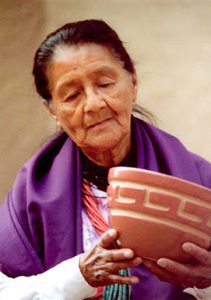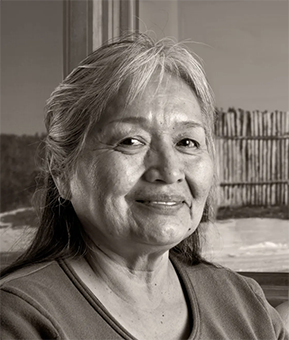Glenna Maxey Goodacre was an American sculptor, best known for having designed the obverse of the Sacagawea dollar that entered circulation in the US in 2000, and the Vietnam Women's Memorial in Washington, D.C.

Olive Rush was a painter, illustrator, muralist, and an important pioneer in Native American art education. Her paintings are held in a number of private collections and museums, including: the Brooklyn Museum of New York City, the Haan Mansion Museum of Indiana Art, the Indianapolis Museum of Art, Indiana and the Smithsonian American Art Museum.

Maria Margarita "Margaret" Tafoya was the matriarch of Santa Clara Pueblo potters. She was a recipient of a 1984 National Heritage Fellowship awarded by the National Endowment for the Arts, which is the United States government's highest honor in the folk and traditional arts.

Pablita Velarde born Tse Tsan was an American Pueblo artist and painter.

Gerald Cassidy was an early 20th-century artist, muralist, and designer who lived in Santa Fe, New Mexico.

Gertrude Prokosch Kurath (1903–1992) was an American dancer, researcher, author, and ethnomusicologist. She researched and wrote extensively on the study of dance, co-authoring several books and writing hundreds of articles. Her main areas of interest were ethnomusicology and dance ethnology, with some of her best known works being "Panorama of Dance Ethnology" in Current Anthropology (1960), the book Music and dance of the Tewa Pueblos co-written with Antonio Garcia (1970), and Iroquois Music and Dance: ceremonial arts of two Seneca Longhouses (1964), in the Smithsonian Institution Bureau of American Ethnology bulletin. She made substantial contributions to the study of Amerindian dance, and to dance theory. From 1958 to January 1972 she was dance editor for the journal Ethnomusicology.

Erna Fergusson was a writer, historian, and storyteller, who documented the culture and history of New Mexico for more than forty years.
Teri Greeves is a Native American beadwork artist, living in Santa Fe, New Mexico. She is enrolled in the Kiowa Indian Tribe of Oklahoma.

Helen Cordero was a Cochiti Pueblo potter from Cochiti, New Mexico. She was renowned for her storyteller pottery figurines, a motif she invented, based upon the traditional "singing mother" motif.
Carmelita "Carm" Little Turtle is an Apache/Tarahumara photographer born in Santa Maria, California, on June 4, 1952. Her hand-painted, sepia-toned photographs explore gender roles, women's rights and the relationships between women and men. Little Turtle's constructed photographic tableaux cast her husband, her relatives, and herself as characters in a variety of Southwestern landscapes that serve as backdrops to the dynamics of interpersonal relationships.

Tonita Peña born as Quah Ah but also used the name Tonita Vigil Peña and María Antonia Tonita Peña. Peña was a renowned Pueblo artist, specializing in pen and ink on paper embellished with watercolor. She was a well-known and influential Native American artist and art teacher of the early 1920s and 1930s.

Ramona Sakiestewa is a contemporary Hopi Native American artist who lives and works in Santa Fe, New Mexico. Sakiestewa is renowned for her tapestries, works on paper, public art, and architectural installations.

Gerónima Cruz Montoya (Potsunu) was an Ohkay Owingeh Pueblo artist and educator from New Mexico. She taught Native American artists at the Studio at the Santa Fe Indian School.
Louise Crow was an American painter. She is best known for her portraits of Puebloans. She worked in oils and watercolors, and with a wide variety of subjects including landscapes, Northwest scenes of rugged mountains, seascapes, and portraits of such historical figures as Ezra Meeker, a pioneer who traveled the Oregon Trail. Her technique was crisp and clean, and is contemporary despite her working nearly one hundred years ago. Much of her work, which has been a challenge to locate, concentrated on California and Southwest themes. Institutions that own her include the New Mexico Museum of Art, the Museum and History and Industry and the Washington State Governor’s Mansion.
Betty Hahn is an American photographer known for working in alternative and early photographic processes. She completed both her BFA (1963) and MFA (1966) at Indiana University. Initially, Hahn worked in other two-dimensional art mediums before focusing on photography in graduate school. She is well-recognized due to her experimentation with experimental photographic methods which incorporate different forms of media. By transcending traditional concepts of photography, Hahn challenges the viewer not only to assess the content of the image, but also to contemplate the photographic object itself.

Christine McHorse, also known as Christine Nofchissey McHorse, was a Navajo ceramic artist from Santa Fe, New Mexico.
Barbara Ann Babcock was an American folklore scholar, professor of Comparative Cultural and Literary Studies, Women's Studies, and American Indian Studies at the University of Arizona.
Aurora Lucero-White Lea was an American folklorist, writer, and suffragist. She was a proud Nuevomexicana, advocating for bilingual education in English and Spanish and working to preserve the heritage of the Hispanic Southwest. Lucero-White Lea is best known for her 1953 work Literary Folklore of the Hispanic Southwest, a compilation of cultural traditions, songs, and stories collected while traveling northern New Mexico.

Leonora Scott Curtin was an American botanist and philanthropist.












